stop start CHRYSLER CROSSFIRE 2008 1.G User Guide
[x] Cancel search | Manufacturer: CHRYSLER, Model Year: 2008, Model line: CROSSFIRE, Model: CHRYSLER CROSSFIRE 2008 1.GPages: 358, PDF Size: 4.7 MB
Page 167 of 358
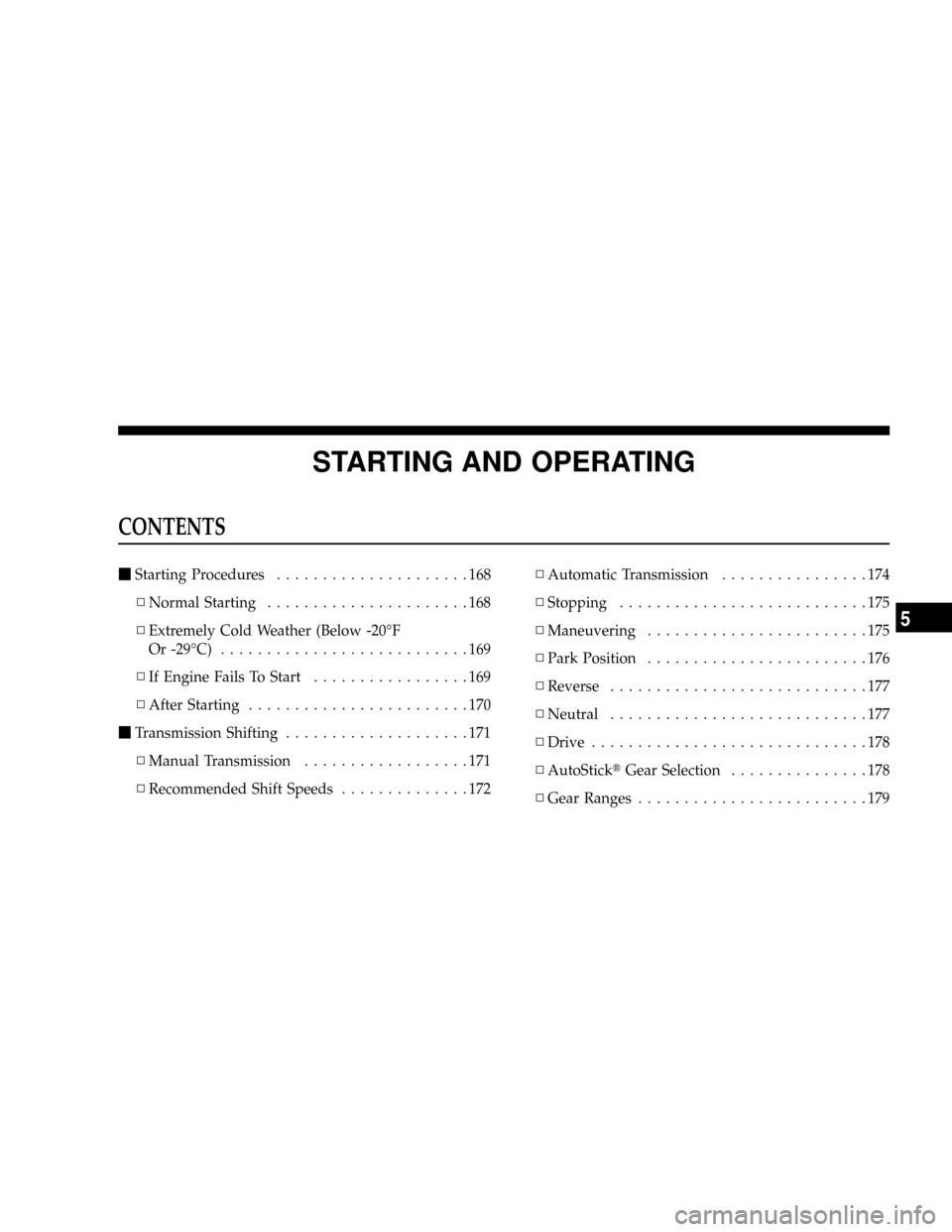
STARTING AND OPERATING
CONTENTS
mStarting Procedures.....................168
NNormal Starting......................168
NExtremely Cold Weather (Below -20ÉF
Or -29ÉC)...........................169
NIf Engine Fails To Start.................169
NAfter Starting........................170
mTransmission Shifting....................171
NManual Transmission..................171
NRecommended Shift Speeds..............172NAutomatic Transmission................174
NStopping...........................175
NManeuvering........................175
NPark Position........................176
NReverse............................177
NNeutral............................177
NDrive..............................178
NAutoSticktGear Selection...............178
NGear Ranges.........................179
5
Page 173 of 358
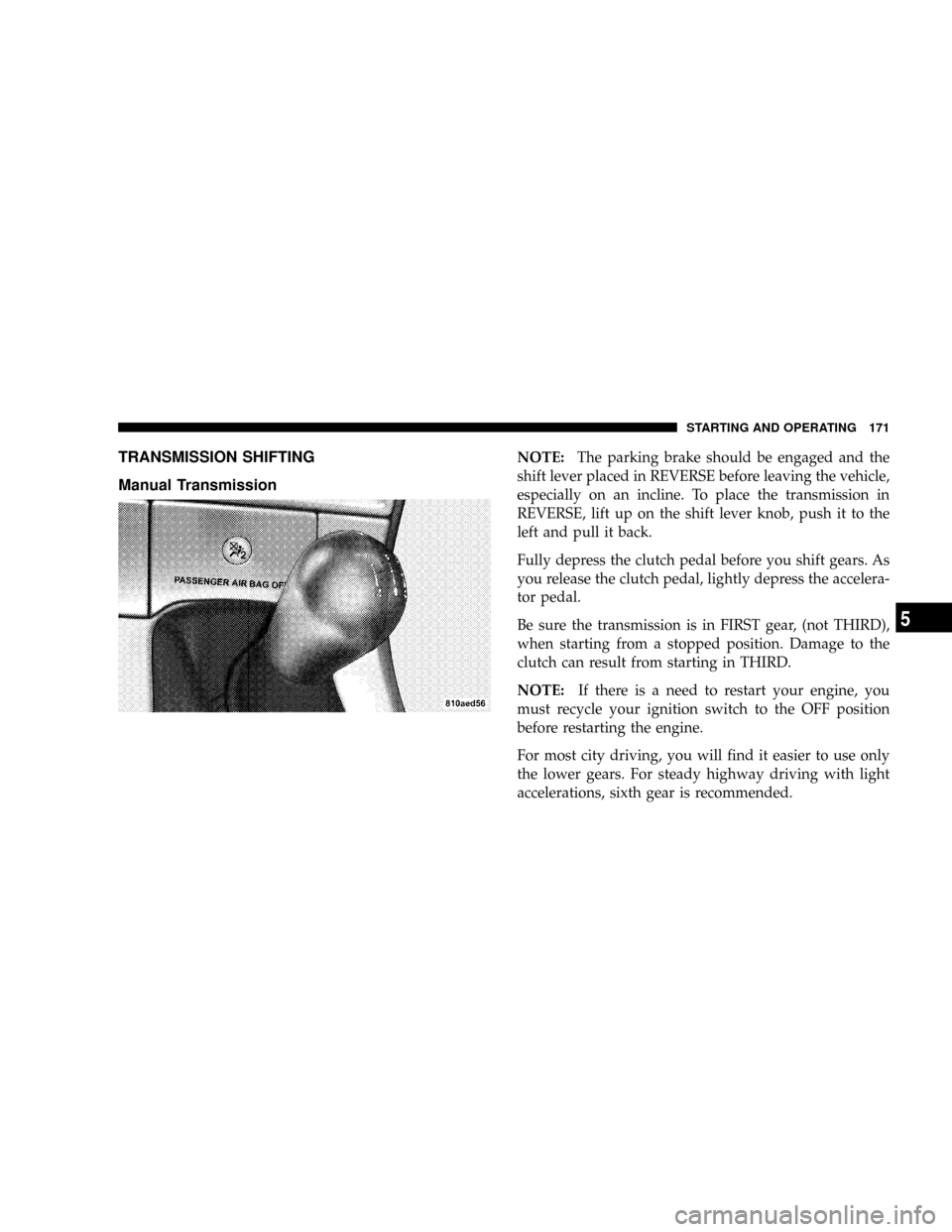
TRANSMISSION SHIFTING
Manual TransmissionNOTE:The parking brake should be engaged and the
shift lever placed in REVERSE before leaving the vehicle,
especially on an incline. To place the transmission in
REVERSE, lift up on the shift lever knob, push it to the
left and pull it back.
Fully depress the clutch pedal before you shift gears. As
you release the clutch pedal, lightly depress the accelera-
tor pedal.
Be sure the transmission is in FIRST gear, (not THIRD),
when starting from a stopped position. Damage to the
clutch can result from starting in THIRD.
NOTE:If there is a need to restart your engine, you
must recycle your ignition switch to the OFF position
before restarting the engine.
For most city driving, you will find it easier to use only
the lower gears. For steady highway driving with light
accelerations, sixth gear is recommended.
STARTING AND OPERATING 171
5
Page 174 of 358
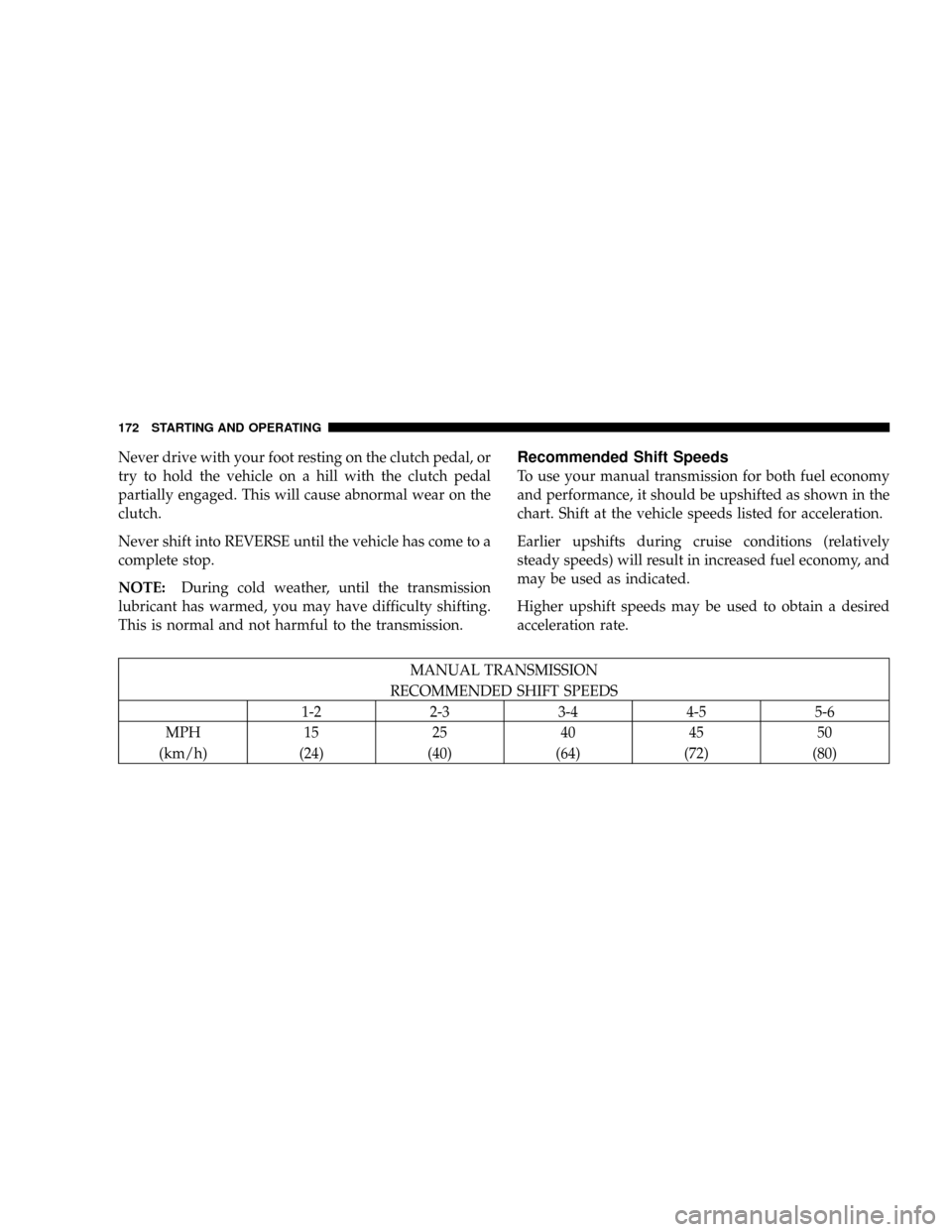
Never drive with your foot resting on the clutch pedal, or
try to hold the vehicle on a hill with the clutch pedal
partially engaged. This will cause abnormal wear on the
clutch.
Never shift into REVERSE until the vehicle has come to a
complete stop.
NOTE:During cold weather, until the transmission
lubricant has warmed, you may have difficulty shifting.
This is normal and not harmful to the transmission.Recommended Shift Speeds
To use your manual transmission for both fuel economy
and performance, it should be upshifted as shown in the
chart. Shift at the vehicle speeds listed for acceleration.
Earlier upshifts during cruise conditions (relatively
steady speeds) will result in increased fuel economy, and
may be used as indicated.
Higher upshift speeds may be used to obtain a desired
acceleration rate.
MANUAL TRANSMISSION
RECOMMENDED SHIFT SPEEDS
1-2 2-3 3-4 4-5 5-6
MPH 15 25 40 45 50
(km/h) (24) (40) (64) (72) (80)
172 STARTING AND OPERATING
Page 177 of 358
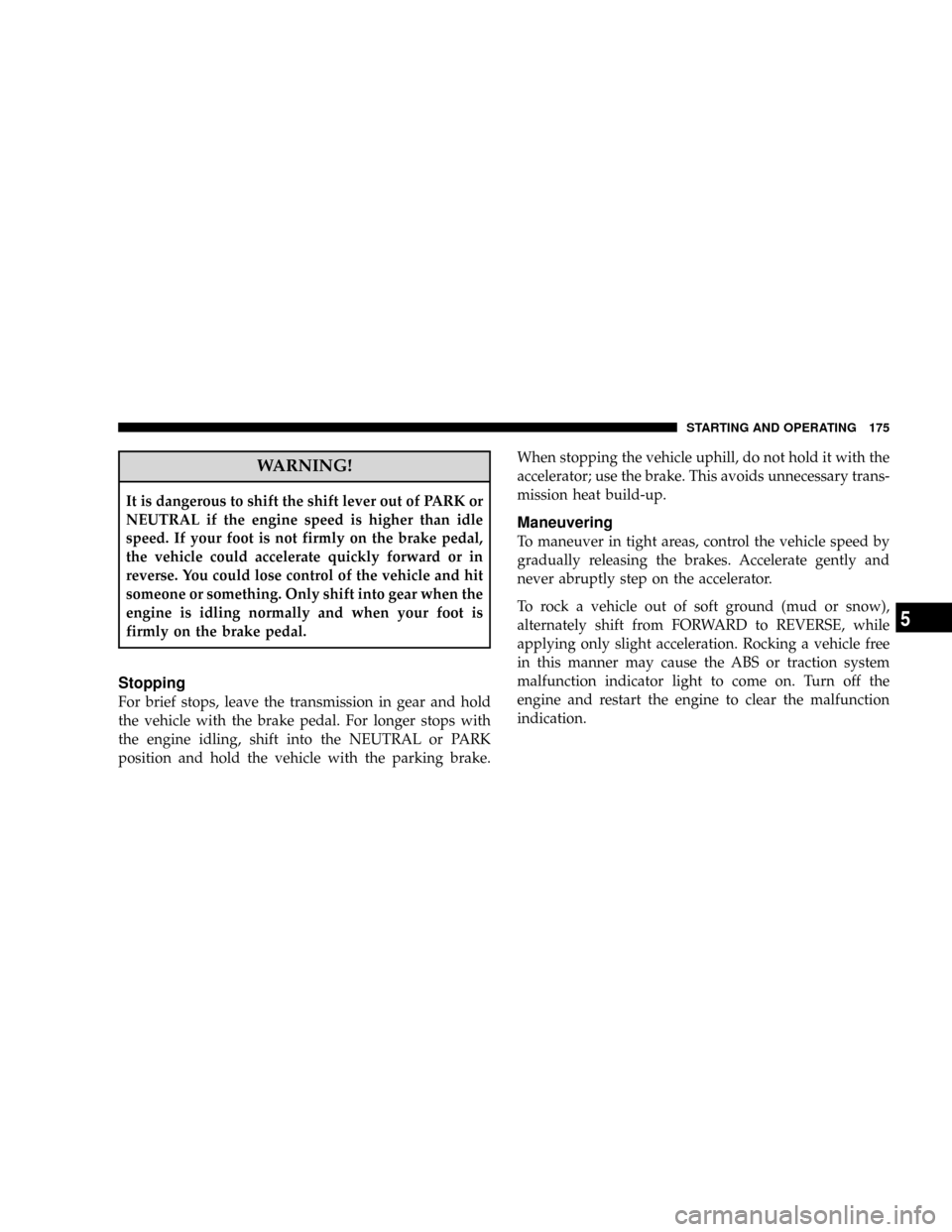
WARNING!
It is dangerous to shift the shift lever out of PARK or
NEUTRAL if the engine speed is higher than idle
speed. If your foot is not firmly on the brake pedal,
the vehicle could accelerate quickly forward or in
reverse. You could lose control of the vehicle and hit
someone or something. Only shift into gear when the
engine is idling normally and when your foot is
firmly on the brake pedal.
Stopping
For brief stops, leave the transmission in gear and hold
the vehicle with the brake pedal. For longer stops with
the engine idling, shift into the NEUTRAL or PARK
position and hold the vehicle with the parking brake.When stopping the vehicle uphill, do not hold it with the
accelerator; use the brake. This avoids unnecessary trans-
mission heat build-up.
Maneuvering
To maneuver in tight areas, control the vehicle speed by
gradually releasing the brakes. Accelerate gently and
never abruptly step on the accelerator.
To rock a vehicle out of soft ground (mud or snow),
alternately shift from FORWARD to REVERSE, while
applying only slight acceleration. Rocking a vehicle free
in this manner may cause the ABS or traction system
malfunction indicator light to come on. Turn off the
engine and restart the engine to clear the malfunction
indication.
STARTING AND OPERATING 175
5
Page 178 of 358
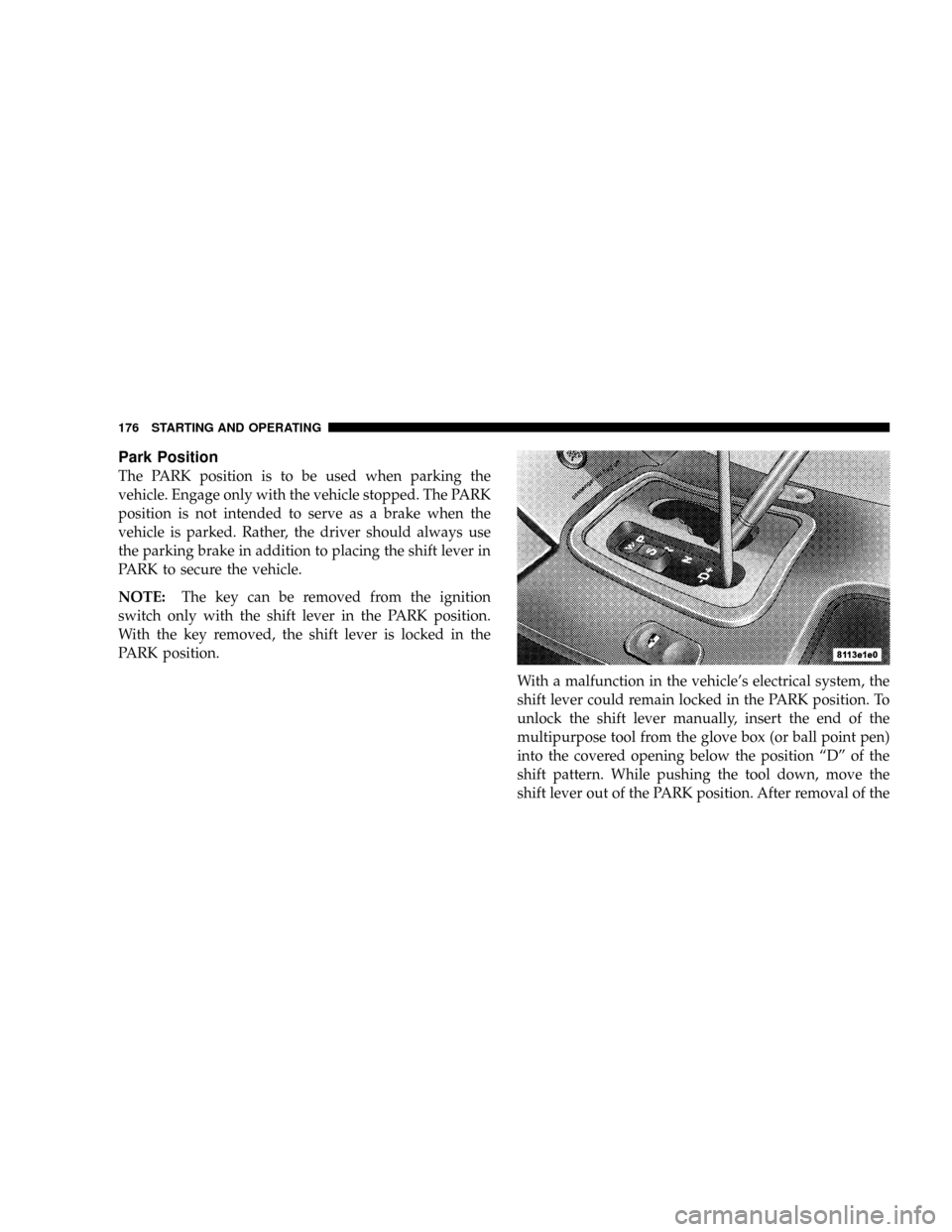
Park Position
The PARK position is to be used when parking the
vehicle. Engage only with the vehicle stopped. The PARK
position is not intended to serve as a brake when the
vehicle is parked. Rather, the driver should always use
the parking brake in addition to placing the shift lever in
PARK to secure the vehicle.
NOTE:The key can be removed from the ignition
switch only with the shift lever in the PARK position.
With the key removed, the shift lever is locked in the
PARK position.
With a malfunction in the vehicle's electrical system, the
shift lever could remain locked in the PARK position. To
unlock the shift lever manually, insert the end of the
multipurpose tool from the glove box (or ball point pen)
into the covered opening below the position ªDº of the
shift pattern. While pushing the tool down, move the
shift lever out of the PARK position. After removal of the
176 STARTING AND OPERATING
Page 179 of 358

tool from the opening, the cover will not close fully. Only
after moving the selector lever to the ªD+º and ªD-º
positions does the cover return to its closed position.Reverse
Shift into REVERSE gear only when the vehicle is com-
pletely stopped.
Dependent on the program mode selector switch position
Standard ªSº and Winter/Wet ªWº (snow and ice), the
maximum speed in the REVERSE gear is different. How-
ever, it is not possible to change the program mode while
in REVERSE.
Neutral
No power is transmitted from the engine to the drive
axle. When the brakes are released, the vehicle can be
moved freely (pushed or towed). Do not engage in
NEUTRAL position while driving except to coast when
the vehicle is in danger of skidding (e.g., on icy roads).
NOTE:Coasting the vehicle, or driving for any other
reason with selector lever in NEUTRAL can result in
transmission damage that is not covered by the Limited
Warranty.
STARTING AND OPERATING 177
5
Page 181 of 358
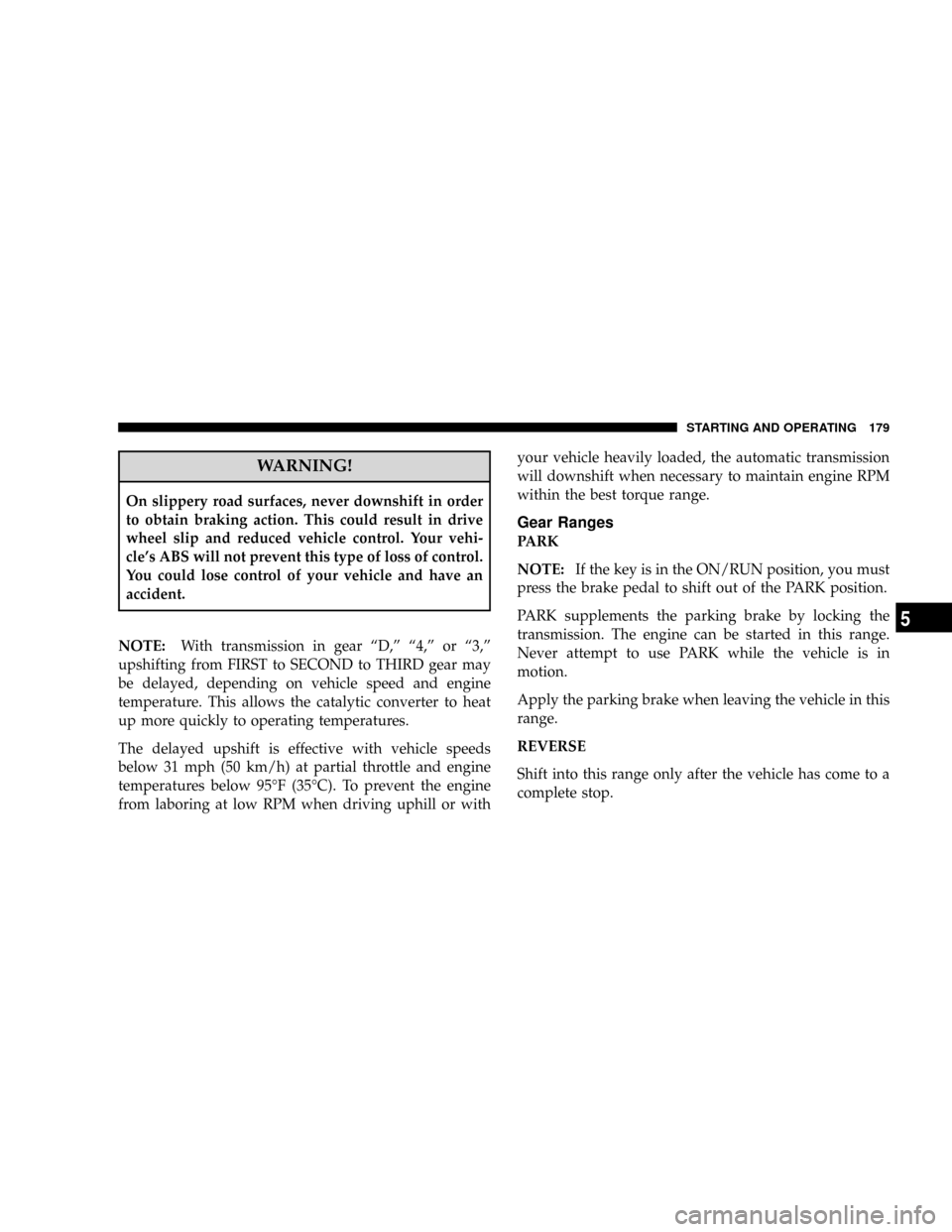
WARNING!
On slippery road surfaces, never downshift in order
to obtain braking action. This could result in drive
wheel slip and reduced vehicle control. Your vehi-
cle's ABS will not prevent this type of loss of control.
You could lose control of your vehicle and have an
accident.
NOTE:With transmission in gear ªD,º ª4,º or ª3,º
upshifting from FIRST to SECOND to THIRD gear may
be delayed, depending on vehicle speed and engine
temperature. This allows the catalytic converter to heat
up more quickly to operating temperatures.
The delayed upshift is effective with vehicle speeds
below 31 mph (50 km/h) at partial throttle and engine
temperatures below 95ÉF (35ÉC). To prevent the engine
from laboring at low RPM when driving uphill or withyour vehicle heavily loaded, the automatic transmission
will downshift when necessary to maintain engine RPM
within the best torque range.
Gear Ranges
PARK
NOTE:If the key is in the ON/RUN position, you must
press the brake pedal to shift out of the PARK position.
PARK supplements the parking brake by locking the
transmission. The engine can be started in this range.
Never attempt to use PARK while the vehicle is in
motion.
Apply the parking brake when leaving the vehicle in this
range.
REVERSE
Shift into this range only after the vehicle has come to a
complete stop.
STARTING AND OPERATING 179
5
Page 183 of 358
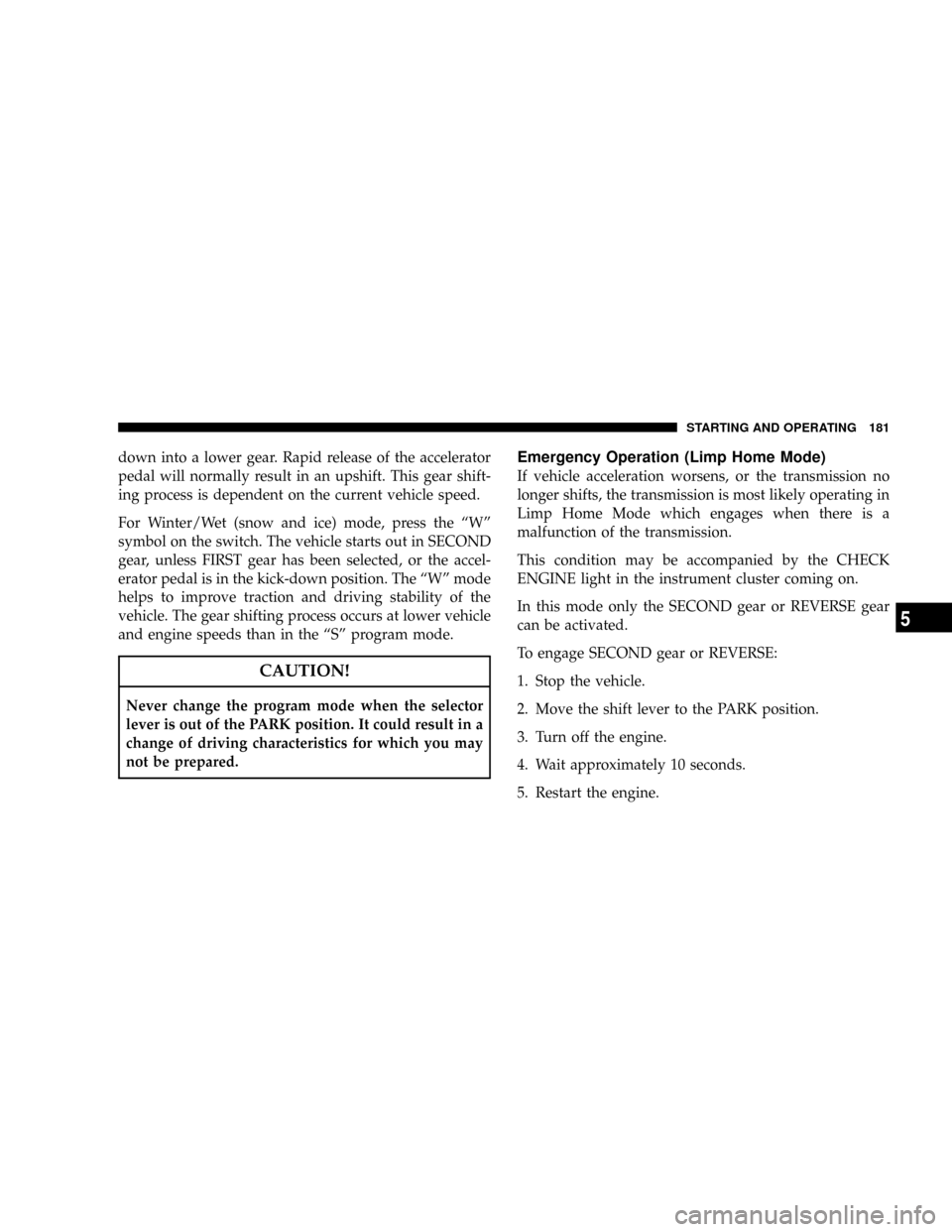
down into a lower gear. Rapid release of the accelerator
pedal will normally result in an upshift. This gear shift-
ing process is dependent on the current vehicle speed.
For Winter/Wet (snow and ice) mode, press the ªWº
symbol on the switch. The vehicle starts out in SECOND
gear, unless FIRST gear has been selected, or the accel-
erator pedal is in the kick-down position. The ªWº mode
helps to improve traction and driving stability of the
vehicle. The gear shifting process occurs at lower vehicle
and engine speeds than in the ªSº program mode.
CAUTION!
Never change the program mode when the selector
lever is out of the PARK position. It could result in a
change of driving characteristics for which you may
not be prepared.
Emergency Operation (Limp Home Mode)
If vehicle acceleration worsens, or the transmission no
longer shifts, the transmission is most likely operating in
Limp Home Mode which engages when there is a
malfunction of the transmission.
This condition may be accompanied by the CHECK
ENGINE light in the instrument cluster coming on.
In this mode only the SECOND gear or REVERSE gear
can be activated.
To engage SECOND gear or REVERSE:
1. Stop the vehicle.
2. Move the shift lever to the PARK position.
3. Turn off the engine.
4. Wait approximately 10 seconds.
5. Restart the engine.
STARTING AND OPERATING 181
5
Page 184 of 358
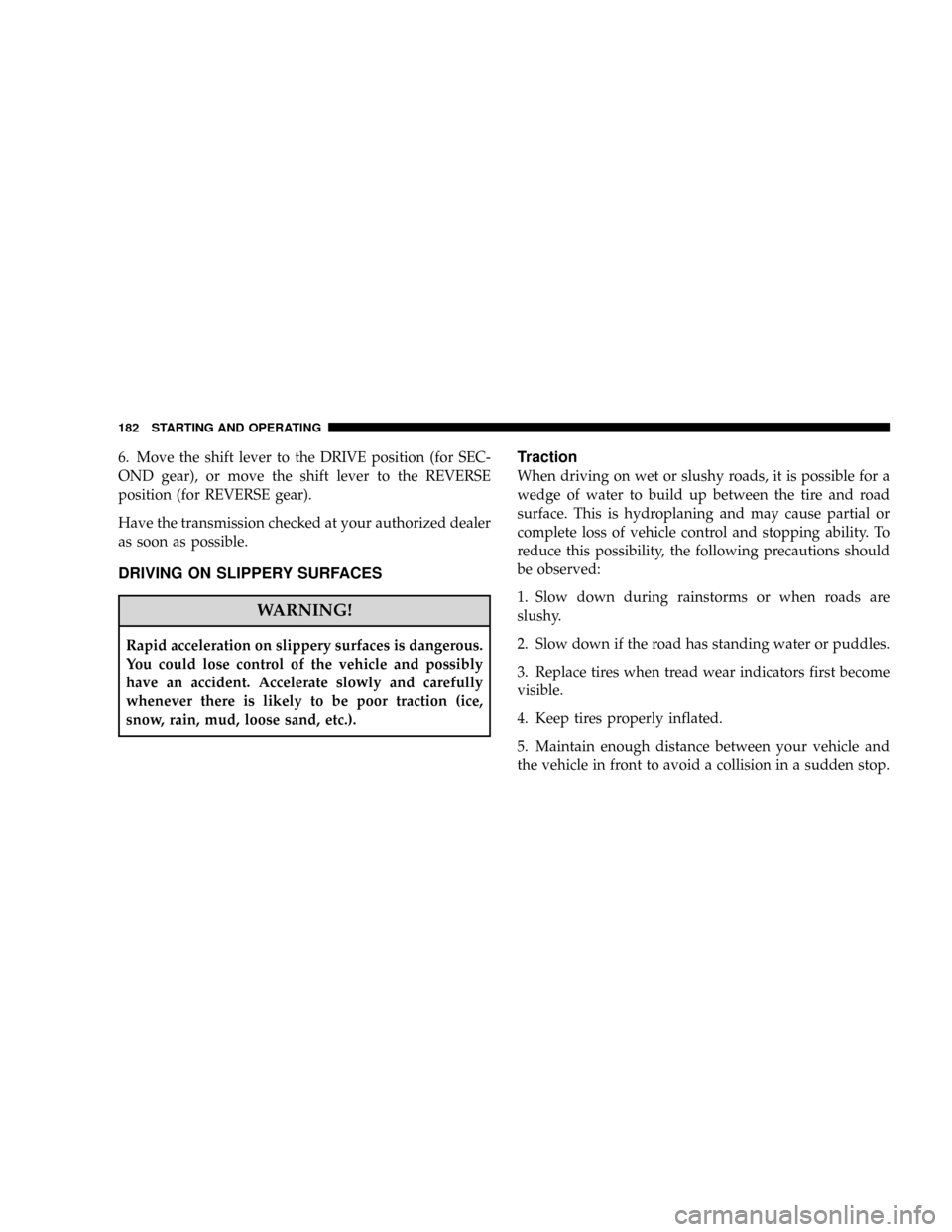
6. Move the shift lever to the DRIVE position (for SEC-
OND gear), or move the shift lever to the REVERSE
position (for REVERSE gear).
Have the transmission checked at your authorized dealer
as soon as possible.
DRIVING ON SLIPPERY SURFACES
WARNING!
Rapid acceleration on slippery surfaces is dangerous.
You could lose control of the vehicle and possibly
have an accident. Accelerate slowly and carefully
whenever there is likely to be poor traction (ice,
snow, rain, mud, loose sand, etc.).
Traction
When driving on wet or slushy roads, it is possible for a
wedge of water to build up between the tire and road
surface. This is hydroplaning and may cause partial or
complete loss of vehicle control and stopping ability. To
reduce this possibility, the following precautions should
be observed:
1. Slow down during rainstorms or when roads are
slushy.
2. Slow down if the road has standing water or puddles.
3. Replace tires when tread wear indicators first become
visible.
4. Keep tires properly inflated.
5. Maintain enough distance between your vehicle and
the vehicle in front to avoid a collision in a sudden stop.
182 STARTING AND OPERATING
Page 186 of 358

CAUTION!
²Driving through standing water may cause dam-
age to your vehicle's drivetrain components. Al-
ways inspect your vehicle's fluids (i.e., engine oil,
transmission, axle, etc.) for signs of contamination
(i.e., fluid that is milky or foamy in appearance)
after driving through standing water. Do not con-
tinue to operate the vehicle if any fluid appears
contaminated, as this may result in further dam-
age. Such damage is not covered by the New
Vehicle Limited Warranty.
²Getting water inside your vehicle's engine can
cause it to lock up and stall out, and cause serious
internal damage to the engine. Such damage is not
covered by the New Vehicle Limited Warranty.
WARNING!
²Driving through standing water limits your vehi-
cle's traction capabilities. Do not exceed 5 mph (8
km/h) when driving through standing water.
²Driving through standing water limits your vehi-
cle's braking capabilities, which increases stop-
ping distances. Therefore, after driving through
standing water, drive slowly and lightly press on
the brake pedal several times to dry the brakes.
²Getting water inside your vehicle's engine can
cause it to lock up and stall out, and leave you
stranded.
²Failure to follow these warnings may result in
injuries that are serious or fatal to you, your
passengers, and others around you.
184 STARTING AND OPERATING